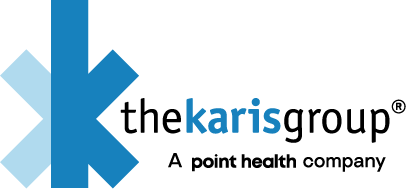Being a leader is tough. When you're a leader in your organization, people expect you to have all the answers.
As CEO of The Karis Group, I am constantly looking to learn from other leaders who, through focused and diligent effort, have become experts in their domain. To that end, I’m starting a new blog series interviewing thought leaders in the health benefits and cost containment space to share their hard-earned knowledge with the rest of us.
For my first blog, I had the pleasure of interviewing Nelson Griswold, author, visionary, keynote speaker, and healthcare disruptor. Nelson is an innovator benefits industry thought leader and bestselling author of NextGeneration Healthcare and Breaking Through the Status Quo. His efforts in disrupting a broken industry have now launched a benefits revolution.
In our interview, Nelson shared his strategies for reducing employer healthcare costs, increasing quality, improving client value and becoming the lead disrupter for your tribe:
Kim Evans: Many HR Directors and CFOs are struggling with the ever-increasing costs of providing healthcare coverage to their employees, and they feel like they are stuck in a revolving door with no exit. Where would you tell one of these leaders to start as they look to contain costs and escape status quo healthcare?
Nelson Griswold: These ever-increasing healthcare costs are sapping company profits even as health insurance premium increases gobble up employee raises and higher out-of-pocket costs eat away at employee savings—not to mention causing many employees to postpone needed care. But there is an alternative to the insanity of renewing the same health insurance plan and expecting different results. Innovative companies that have announced, “Enough is enough!” are engaging NextGen (next-generation) Benefits Advisers who are working with the CEO, CFO, and HR to take control of their benefits spend in order to purchase and manage healthcare differently.
A company leader’s first step is terminating the insurance company’s fully insured health plan. Next, these employers are moving to alternative funding strategies such as dividend-eligible health plans that return unused claims dollars at the end of the year and medical cost-sharing arrangements. Now in control of their healthcare spend, these companies are using NextGen Advisers to help them begin managing their healthcare supply chain to control the quality and cost of the medical products and services that employees purchase.
These proven strategies are saving employers thousands of dollars per employee while improving the benefits for the employees. One 20-person company, Online Enterprises, Inc. in Wadsworth, OH, in 2018 cut their Per-Employee-Per-Year (PEPY) benefits cost by $6,150 – a 56% (!) reduction – in the first year of a cost-sharing based program, saving the company over $123,000 in its year-over-year spend while providing employees with better and more affordable benefits.
Garden State Engineering Surveying and Planning (GSESP), a 60-life company in Maywood, NJ, in 2017, moved to a dividend-eligible health plan that managed the employees’ healthcare purchases. In just 12 months, GSESP lowered its year-over-year healthcare costs by 26 percent, which allowed the company to eliminate the $5,750 family deductible for employees. Lower costs, better benefits. These alternative funding strategies work equally well for large companies.
Progressive CEOs, CFOs, and HR leaders who have had enough of the annual insanity that is the Status Quo are joining this Benefits Revolution. Assisted by NextGen Benefits Advisers, these companies are moving beyond the broken benefits and health care Status Quo to a new model that controls and reduces health care costs while improving benefits for employees.
Kim Evans: You are one of the leading thinkers that brokers & benefits advisers look to when they are trying to disrupt the traditional health benefits approach. What are the practical steps you would share with brokers & benefits advisers looking to drive down costs, increase quality, and ultimately improve value for their clients?
Nelson Griswold: There is a new breed of advisers – known as NextGen Benefits Advisers – who are rejecting the Status Quo in benefits and health care that consistently produces annual premium increases for the same or lesser benefits. These NextGen advisers are part of the Benefits Revolution that is changing their relationship with their employer client and changing how the employer purchases and manages health care.
Many of the NextGen Benefits strategies – e.g., self-funding and many tactics for managing the health care supply chain to control costs – have a fairly steep learning curve and require substantial time and effort to master. But brokers can start with some much easier steps on the journey to becoming a NextGen Benefits Adviser.
1. The first step involves moving to a transparent compensation model.
The traditional carrier-paid compensation model – whether commission or a PMPM fee – poses two critical problems. First, since we all work for whoever signs our paycheck, brokers who take a commission check work for the insurance company. Period. Second, your clients rarely know how or how much you get paid on their account, which creates a natural level of mistrust. Employers have difficulty trusting that their broker is working on their behalf when they don’t know who pays you, how you get paid, and how much you are paid.
Moving to an employer-paid fee-for-service model, whenever possible, is the obvious solution, so your clients now know who you work for and how and how much you are paid. This transparency differentiates you from your competition and is the basis for becoming a trusted NextGen Benefits Adviser.
2. The second step involves alternative funding strategies to pay for employee health care.
Brokers need to understand that fully insured health plans will never reduce your client’s cost of health care, which is the only way to produce premium reductions at renewal. The carriers’ financial model, especially given the ACA’s rules on Minimum Loss Ratio, requires cost increases in health care to drive up carrier revenue to increase their profits. It’s simple economics. Because it’s not rational to expect any business to work against its own financial interests, you can’t expect the carriers to do anything to reduce the cost of health care.
So next-generation advisers, whenever possible, are moving their small-to-mid-market clients into some version of alternative funding, such as level-funded plans or medical cost-sharing arrangements. If it’s a level-funded plan, it must return the employer unused claims dollars at the end of the plan year. Of course, medical cost-sharing is not a fit for all employers, but when it is, those groups can save substantial costs over a fully insured health plan. And not all groups will meet the underwriting requirements of level-funded plans. But those employers that do qualify will pay only for the health care their employees actually use, saving themselves the difference between premiums paid and claims paid, less the administrative fees.
Advisers who move their compensation to a fee-for-service model and move their clients to alternative funding – first steps to becoming a NextGen Benefits Adviser – are earning a rush of new business, as they win accounts from brokers stuck in the Status Quo.
Kim Evans: Let’s talk about price transparency. Can you explain your take on price transparency (or the lack thereof) in healthcare and provide some tips for those looking to understand better the pricing structures their clients and employees face?
Nelson Griswold: Employers – the main payer in the U.S. healthcare system beside the federal government – manage health care differently from every other purchase the company makes. Companies aggressively manage the quality and cost of all parts and supplies – their supply chain – often negotiating the price of bulk purchases such as paperclips or ball bearings down to a tenth of one cent. Yet these same companies will pay the six-figure cost of an employee’s open-heart surgery without question because the CEOs and CFOs don’t manage their health care supply chain.
When companies allow employees to purchase health care procedures and services without first knowing the cost and then unquestioningly pay the billed charges, health care providers have no reason to be transparent with their pricing. No one is asking for the price. Without quality and price transparency, market forces can’t operate, and so there is no competition, which is the market mechanism that keeps prices low.
Health care consumerism – giving employees more “skin in the game” by raising their out-of-pocket costs (deductible and co-insurance) – was touted as an antidote for high health care prices. But consumerism has failed largely due to the lack of sufficient, readily available quality & cost data, i.e., a lack of transparency.
The failure of consumerism has meant that it is up to the employer and the health plan to demand price transparency. Two (admittedly advanced) tactics that advisers are using to address the lack of transparency are Reference Based Pricing (RBP) and medical utilization management.
RBP, which can be controversial, uses the power of the payer’s – the employer’s – checkbook to negotiate down the billed charges from the hospital, which is the biggest culprit in terms of overpriced, abusive health care costs. RBP can easily reduce health care costs by 20-40 percent. But if not executed properly, RBP can create serious problems in the health plan and within the company.
Medical utilization management uses quality and cost data to guide employees toward high-value (high-quality/low-cost) health care providers. Well-designed NextGen health plans will waive the employee’s total out-of-pocket costs if they use the recommended high-value provider(s).
A smaller but often effective tactic an adviser can deploy is a mobile app for employees that offers access to quality and cost data or even provides a benefits concierge to help provide some transparency. Some of these mobile benefit portals even allow for push notifications based on geolocation technology to inform employees who are entering a pharmacy to use a discount program in the app to reduce drug costs or who are entering a doctor’s office to avoid their co-payment and the long wait for the doctor by using the telemedicine program available through the app.
All of these and any other tactic that is intended to lower health care costs can have a financial impact only when alternative funding – level-funding, self-funding, medical cost-sharing – is used to pay for the cost of health care.
Lack of transparency is inherent in our Status Quo healthcare system, but many innovative advisers are forcing transparency one employee at a time.
Kim Evans: Twenty years from now, when you look back on your time in the health benefits industry, what will you be most proud of?
Nelson Griswold: I hope my lasting legacy will be a free-market U.S. healthcare system that is driven by market forces to make the highest quality care affordable to all Americans. The Benefits Revolution that I help lead is changing the health care delivery system one company at a time, so the Revolution needs many more disruptive advisers who will take these proven strategies and tactics into more and more companies across the country. If we can recruit enough advisers, we can save and improve U.S. health care and make it available to all Americans.
To learn more about Nelson Griswold and how he has been leading disruption in a broken industry, you can follow him on LinkedIn and visit NextGen Benefit Advisers.
To learn more about The Karis Group and our Karis Cost Containment Services you can visit our What We Do page or Contact Us to schedule an intro call.





